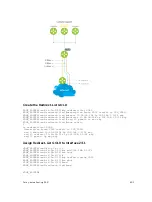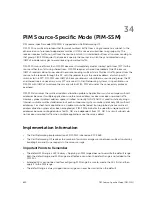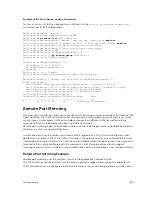
34
PIM Source-Specific Mode (PIM-SSM)
PIM source-specific mode (PIM-SSM) is supported on Dell Networking OS.
PIM-SSM is a multicast protocol that forwards multicast traffic from a single source to a subnet. In the
other versions of protocol independent multicast (PIM), a receiver subscribes to a group only. The
receiver receives traffic not just from the source in which it is interested but from all sources sending to
that group. PIM-SSM requires that receivers specify the sources in which they are interested using
IGMPv3 include messages to avoid receiving unwanted traffic.
PIM-SSM is more efficient than PIM-SM because it immediately creates shortest path trees (SPT) to the
source rather than first using shared trees. PIM-SM requires a shared tree rooted at the RP because
IGMPv2 receivers do not know about the source sending multicast data. Multicast traffic passes from the
source to the receiver through the RP, until the receiver learns the source address, at which point it
switches to the SPT. PIM-SSM uses IGMPv3. Because receivers subscribe to a source and group, the RP
and shared tree is unnecessary; only SPTs are used. On Dell Networking systems, it is possible to use
PIM-SM with IGMPv3 to achieve the same result, but PIM-SSM eliminates the unnecessary protocol
overhead.
PIM-SSM also solves the multicast address allocation problem. Applications must use unique multicast
addresses because if multiple applications use the same address, receivers receive unwanted traffic.
However, global multicast address space is limited. Currently GLOP/EGLOP is used to statically assign
Internet-routable multicast addresses, but each autonomous system number yields only 255 multicast
addresses. For short-term applications, an address could be leased, but no global dynamic multicast
address allocation scheme has been accepted yet. PIM-SSM eliminates the need for unique multicast
addresses because routing decisions for (S1, G1) are independent from (S2, G1). As a result, subnets do
not receive unwanted traffic when multiple applications use the same address.
Implementation Information
• The Dell Networking implementation of PIM-SSM is based on RFC 3569.
• The Dell Networking OS reduces the number of control messages sent between multicast routers by
bundling Join and Prune requests in the same message.
Important Points to Remember
• The default SSM range is 232/8 always. Applying an SSM range does not overwrite the default range.
Both the default range and SSM range are effective even when the default range is not added to the
SSM ACL.
• Extended ACLs cannot be used for configuring SSM range. Be sure to create the ACL first and then
apply it to the SSM range.
• The default range is always supported, so range can never be smaller than the default.
612
PIM Source-Specific Mode (PIM-SSM)
Summary of Contents for Z9000
Page 1: ...Dell Configuration Guide for the Z9000 System 9 7 0 0 ...
Page 80: ...grub reboot 80 Management ...
Page 128: ... 0 Te 1 1 Te 1 2 rx Flow N A N A 128 Access Control Lists ACLs ...
Page 491: ...Figure 70 Configuring OSPF and BGP for MSDP Multicast Source Discovery Protocol MSDP 491 ...
Page 496: ...Figure 73 MSDP Default Peer Scenario 1 496 Multicast Source Discovery Protocol MSDP ...
Page 497: ...Figure 74 MSDP Default Peer Scenario 2 Multicast Source Discovery Protocol MSDP 497 ...
Page 498: ...Figure 75 MSDP Default Peer Scenario 3 498 Multicast Source Discovery Protocol MSDP ...
Page 760: ...Figure 100 Single and Double Tag TPID Match 760 Service Provider Bridging ...
Page 761: ...Figure 101 Single and Double Tag First byte TPID Match Service Provider Bridging 761 ...
















































